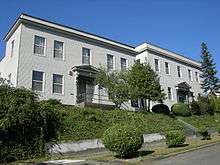Nihon Go Gakko (Seattle)
Nihon Go Gakko (シアトル日本語学校 Shiatoru Nihongo Gakko) also known as the Japanese Language School (JLS) is a National Register of Historic Places in King County based at the Japanese Cultural and Community Center of Washington located on the periphery of the Seattle International District. The JLS provides Japanese language classes to both children and adults. Originally known as Kokugo Gakko,[1] it is also the oldest Japanese language school in North America.[2]

Since the combination of the Nikkei Heritage Association of Washington and the JLS in 2003 to form the Japanese Cultural and Community of Washington (JCCCW), a 501(c)3 nonprofit, the JLS has become its premier program.
History
Established in 1902 on the second floor of the Furuya Company building in Seattle's Pioneer Square–Skid Road Historic District,[3] the first class of the Japanese school was headed by Yoshio Shibayama with a class of four students. By 1907 there were a total of 48 students. In 1913, the school moved to its current location at Weller and 16th Street.[4]
By 1920, the school had grown to seven teachers and 251 students. In 1930, there were 24 teachers and more than 1,000 students.[4] In 1938 the school opened its doors to adults, offering evening classes. When World War II broke out and the Japanese Americans in the area were sent to internment camps, the U.S. military occupied the school for use as an Army Air Force training facility.
After World War II ended and interned Japanese Americans began to return to the Seattle area, the school was re-purposed as "Hunt's Hotel" and would house many returnee Japanese Americans as they looked for new homes and occupations.[5] More than 130 people lived in the building's classrooms over a period of almost 15 years, as they attempted to rebuild their lives.[6]
Today, the Nihon Go Gakko is home to the Japanese Cultural and Community Center of Washington which was the combination of the Nikkei Heritage Association of Washington (NHAW) and the JLS. The JLS is used by the JCCCW to promote Japanese language and culture.
References
| Wikimedia Commons has media related to Seattle Nihon Go Gakko. |
- "Seattle Japanese Language School seeking photos of past events", Northwest Asian Weekly, August 10, 2012
- Nakamura, Kelli Y. "Japanese Language Schools". Densho Encyclopedia. Retrieved 2020-06-06.
- Asato, Noriko (2005). Teaching Mikadoism: The Attack on Japanese Language Schools in Hawaii, California, and Washington, 1919-1927. University of Hawaii Press. p. 80. ISBN 978-0824828981.
- Asato, Noriko (2005). Teaching Mikadoism: The Attack on Japanese Language Schools in Hawaii, California, and Washington, 1919-1927. University of Hawaii Press. p. 81. ISBN 978-0824828981.
- Cohen, Aubrey (June 8, 2007), "Japanese center holds memories of Hunt Hotel", Seattle Post-Intelligencer
- "New Exhibit Shares Memories of Hunt Hotel". www.discovernikkei.org. 2016-03-09.
External links
- "Japanese Cultural and Community of Washington (JCCCW)". Retrieved 2020-06-07.
- "Seattle Historical Sites: Japanese Language School". Retrieved 2020-06-09.